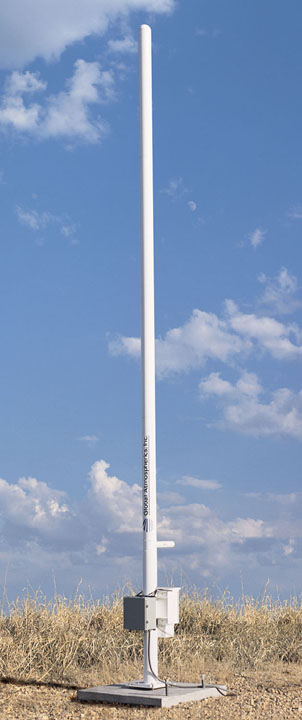Lightning Detection in a Flash
Thunderstorms may always remain an erratic and unpredictable force of nature. Unfortunately, when lightning strikes serious damage can occur. This risk must be thoroughly analyzed and precautions must be taken—especially when multi-million dollar vehicles, such as Space Shuttles, are at risk. In a joint project with NASA's Kennedy Space Center, Global Atmospherics, Inc. (GAI), participated in the upgrade and commercialization of the Lightning Detection and Ranging (LDAR) System. Under a Space Act Agreement, GAI and Kennedy agreed to the joint development of a new LDAR system that meets the needs of both NASA and private industry.
Kennedy Space Center averages 75 thunderstorm days per year, so lightning warnings are nothing new, especially in the hot, humid months of summer. NASA needed a system that could minimize unnecessary warnings and maximize work productivity without sacrificing the safety of its personnel and projects. The resulting development was a volumetric lightning mapping system.
NASA operates a three-dimensional LDAR system capable of determining the exact location and altitude of in-cloud and cloud-to-cloud lightning. This is done through the analysis of the exact arrival times of electromagnetic pulses. The times are collected using seven antennae stationed around the region that detect VHF radiation. The collected data is then analyzed, geo-located in three dimensions, and transmitted to the Weather Squadron, 45th Space Wing, Patrick Air Force Base, Satellite Beach, Florida, and to the National Weather Service personnel at Johnson Space Center, Texas and in Melbourne, Florida. They use the data to define the existence and volumetric extent of the potential lightning hazard for the space program and Central Florida. GAI was able to see the numerous opportunities and applications of a system that could provide accurate projections of lightning patterns in almost real-time, and made a good thing better.
GAI is the world's largest manufacturer of lightning detection and location equipment, providing service to customers in over 40 countries. They also serve as owner and operator of the U.S. National Lightning Detection Network (NLDN). While the NLDN is able to plot the strike locations of each cloud-to-ground flash, it does not locate in-cloud and cloud-to-cloud flashes.
Under the Space Act Agreement, GAI contributed its wealth of experience and resources to update and improve the current lightning mapping system used by NASA. Previously, commercial systems were only capable of locating cloud-to-ground lightning. The resulting innovations allowed GAI to position the LDAR system for commercial applications. The upgraded product has the ability to measure in-cloud and cloud-to-cloud lightning. Notable improvements have also been made in the system's location accuracy and signal detection.
The new product, known as LDAR II, is targeted for use by utility providers, aviation companies, airports, and commercial space vehicle launch facilities. Presently, forecasting services, research facilities, and a utility company are using the system. Weather forecasting services use LDAR II to view the height and horizontal extension of each lightning flash. The LDAR II antenna consists of a fiberglass lightning mast containing signal processors that provide data to a computer. The user can then interpret the data, analyze the risks, and take the necessary precautions.
There are obvious safety benefits associated with the use of LDAR II. Annually, lightning kills more Florida citizens than any other weather hazard. It is hoped that the widespread use of the LDAR systems will reduce this sort of tragedy. For example, the National Weather Service used the technology to assist with weather forecasts during the World Olympic soccer tournaments held in Orlando, Florida, during the summer of 1996. Without the projective capabilities of the LDAR system, thousands of spectators could have been placed in the path of serious injury with no forewarning of a possible lightning strike. From the protection of people to space vehicles, electric companies to launch pads, GAI and NASA created a technology full of safety and operational benefits.

The LDAR II fiberglass lightning mast contains signal processors that provide data to a computer where the user can then interpret the extent of lightning hazard.













